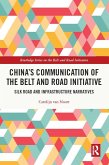By carefully selecting infrastructure modalities and Silk Road representations, it is argued that China's aesthetic production of the Belt and Road Initiative advances China's image as an infrastructure and standards-setting power, conjures up a historical continuation of friendly and cooperative relations, and forges China's identity as good neighbor, good friend, and good partner. Using a multiple-case study approach, this book analyses China's communication of the Second Belt and Road Forum, the Alternative North-South Road in Kyrgyzstan, the Standard Gauge Railway in Kenya, and the China-Maldives Friendship Bridge. Detailed literary analyses of the Travels of Marco Polo and the Travels of Ibn Battutah further elucidate China's selective uses of history. Chapters highlight spatial, temporal, political, economic, technological, and perceptual modalities in infrastructure narratives, and reveal the composition of Silk Road narratives, contributing to key debates about Chinese discourse, media strategy and infrastructure communication.
China's Communication of the Belt and Road Initiative will appeal to students and scholars of politics, international relations, communication, and Asian studies globally.
Dieser Download kann aus rechtlichen Gründen nur mit Rechnungsadresse in A, B, BG, CY, CZ, D, DK, EW, E, FIN, F, GR, HR, H, IRL, I, LT, L, LR, M, NL, PL, P, R, S, SLO, SK ausgeliefert werden.
Tim Winter, University of Western Australia
"Carolijn van Noort's book is an excellent interdisciplinary study on how China communicates its Belt and Road Initiative at the global stage through narrating about infrastructure and Silk Road. A must-read for those who are interested in strategic communications and China's Belt and Road."
Jinghan Zeng, Lancaster University
"In this remarkable study, Dr. van Noort provides a methodologically ambitious and precise, conceptually clear, and empirically rich account of China's strategic narratives. This book discloses across three fascinating case studies the crucial role those narratives play in global politics. Dr. van Noort deploys a deep understanding of a variety of topics and resources, including history, communication, and visual politics, in this dynamic book. It is that rare study that is both intellectually rigorous and enjoyable, even exciting, to read."
Brent J. Steele, The University of Utah









